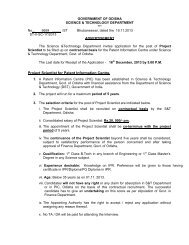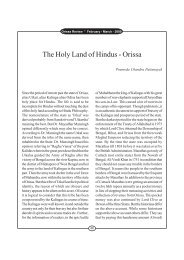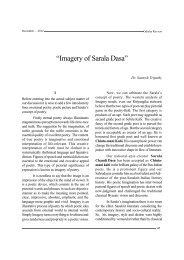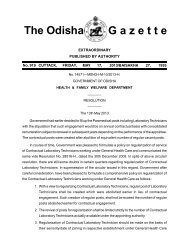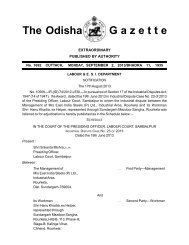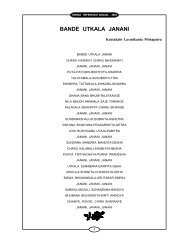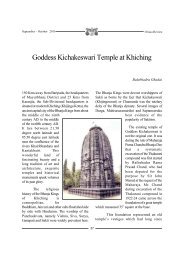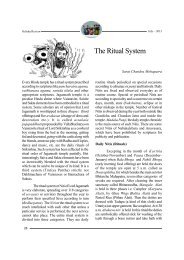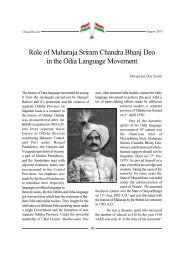Mahima Dharma, Bhima Bhoi and Biswanathbaba
Mahima Dharma, Bhima Bhoi and Biswanathbaba
Mahima Dharma, Bhima Bhoi and Biswanathbaba
You also want an ePaper? Increase the reach of your titles
YUMPU automatically turns print PDFs into web optimized ePapers that Google loves.
Orissa Review * May - 2005<br />
<strong>Mahima</strong> <strong>Dharma</strong>, <strong>Bhima</strong> <strong>Bhoi</strong> <strong>and</strong><br />
<strong>Biswanathbaba</strong><br />
If you happen to see a man clad with saffron robe,<br />
having knotted hair on his head, a bag dangling<br />
from his shoulder, a palm-leaf umbrella over his<br />
head, walking with down-ward glance, singing<br />
<strong>Bhima</strong> <strong>Bhoi</strong>'s Bhajans to the music of his<br />
castanet, prostrating before sunrise <strong>and</strong> sunset,<br />
smearing his forehead with dust or eating from an<br />
earthen pot or leaf plates, sleeping beneath the<br />
open sky beside a burning log or Dhuni, you can<br />
instantly conclude, here is a <strong>Mahima</strong> Baba or a<br />
Kumbhipatia Baba, (Satya <strong>Mahima</strong> <strong>Dharma</strong><br />
12-18).<br />
<strong>Mahima</strong> <strong>Dharma</strong> is a religion founded by<br />
one Mukunda Das alias <strong>Mahima</strong> Swami who<br />
hailed from Baudh ex-state <strong>and</strong> belonged to a<br />
Brahmin family. At first he was in charge of<br />
Balasingha Math of Baudh. He attained siddhi at<br />
Kapilas hill in 1862 A.D., founded <strong>Mahima</strong><br />
<strong>Dharma</strong>, from there came to Balasingha <strong>and</strong><br />
initiated his first disciple, Jagannath Das of<br />
Balasingha <strong>and</strong> renamed him as Govinda Das.<br />
The poet prophet of this religion was <strong>Bhima</strong><br />
<strong>Bhoi</strong>, whose samadhi at Khaliapali village<br />
situated at a distance of around 12 km to the west<br />
of Sonepur town has become a place of<br />
pilgrimage for the followers of his faith.<br />
The <strong>Mahima</strong>ites touch no prasad or tulsi<br />
leaf or medicine. They entertain no casteism or<br />
idolatry or belief in spirits. They play no games,<br />
25<br />
Bhagirathi Nepak<br />
move with no sanyasini, sit under no canopy,<br />
domesticate no birds or animals. They do not<br />
accept alms from astrologers, prostitutes, barbers,<br />
Brahmins, Kshatriyas (Rajas) <strong>and</strong> Ch<strong>and</strong>als.<br />
Like the Vaishnavas, they wear no sacred<br />
threads, no tilak or mark of Vishnavism, no<br />
garl<strong>and</strong> of beaded tulsi.<br />
They take no dinner, touch no food which<br />
is too salty or too sweet or too bitter.<br />
They perform sarana <strong>and</strong> darsana, beg<br />
food only once from a family, stay only a day<br />
in a village.<br />
They practise truth, non-violence <strong>and</strong><br />
believe in immortality <strong>and</strong> rebirth.<br />
Born in an atmosphere of suppression<br />
<strong>and</strong> distrust, <strong>Mahima</strong>ism opposed the spread<br />
of Christianity <strong>and</strong> Vaishnavism.<br />
It resembles Christianity in its belief in<br />
one God <strong>and</strong> one caste <strong>and</strong> also in bridal <strong>and</strong><br />
funeral ceremonies. But unlike Christianity its<br />
God is Alekh.<br />
Like Vaishnavism, it is based on faith,<br />
but it runs to philosophic abstraction. (To scholars<br />
like B.C. Mazumdar <strong>and</strong> L.N. Sahu this religion<br />
is the culmination of Jainism for its saffron robe,<br />
its non-violence, its code of conduct <strong>and</strong> its<br />
custom of fasting at night, while to others, it is the
modern form of crypto-Buddhism for its theory<br />
of the void, its projection of <strong>Mahima</strong> as Buddha,<br />
non-attachment <strong>and</strong> rejection of casteism, idolatry<br />
<strong>and</strong> the Vedas.<br />
But to Dr. N.N. Basu <strong>and</strong> Professor A.B.<br />
Mohanty, <strong>Mahima</strong> religion evolved from<br />
Mahayana Buddhism.<br />
To P<strong>and</strong>it Vinayak Mishra, it is a branch of<br />
Sahajayana. To P<strong>and</strong>it Nilakantha Das, it is<br />
Tantrayana which developed into a distinct cult.<br />
The Buddhists believe that in the ultimate<br />
there is Nothing, but to the Alekhist, there is only<br />
One after all the appearances disappear. That<br />
again has no appearance. Like Sankaracharya,<br />
the <strong>Mahima</strong>ites believe in Monism, but they have<br />
no place of Maya in their scheme of things.<br />
Though <strong>Mahima</strong> religion bears the stamps<br />
of Jainism, Buddhism, Christianity <strong>and</strong> Hinduism,<br />
it has its own indissoluble identity.<br />
<strong>Mahima</strong> <strong>Dharma</strong> contains the essence of<br />
all cults of the world. Orissa during the 19th<br />
century, in the context of the Indian renaissance<br />
<strong>and</strong> the social <strong>and</strong> political changes which took<br />
place all over the world was indeed a virgin l<strong>and</strong><br />
for the rise of the <strong>Mahima</strong> <strong>Dharma</strong>.<br />
<strong>Mahima</strong> <strong>Dharma</strong> originated in Orissa in the<br />
second half of the 19th century. It took its birth<br />
out of the two great religions i.e. Hinduism <strong>and</strong><br />
Buddhism.<br />
<strong>Mahima</strong> <strong>Dharma</strong> is the last protest of saints<br />
against the established Hindu religious order.<br />
The great Prabuddha Guru <strong>Mahima</strong><br />
Gosain founded <strong>and</strong> preached the religion called<br />
"<strong>Mahima</strong> <strong>Dharma</strong>".<br />
<strong>Mahima</strong> <strong>Dharma</strong> is also called "Satya<br />
Sanatan <strong>Mahima</strong> <strong>Dharma</strong>". It is Satya <strong>and</strong><br />
Orissa Review * May - 2005<br />
26<br />
Sanatan, being a branch of the Sanatan Hindu<br />
<strong>Dharma</strong>.<br />
The philosophical truth on which Satya<br />
<strong>Mahima</strong> <strong>Dharma</strong> is founded is that, "The ultimate<br />
reality is One <strong>and</strong> the only One. The human mind<br />
through ages has worshipped the One as<br />
manifested in many. But the true worship is, in the<br />
words of <strong>Bhima</strong> <strong>Bhoi</strong> "to come down to the stem<br />
leaving the branches". In other words, to withdraw<br />
from the many to One <strong>and</strong> the only One.<br />
This theory of oneness of the Supreme<br />
Reality of the One <strong>and</strong> only one God is known in<br />
Indian philosophy as Advaitabada.<br />
Advaitabada has been the doctrine of many great<br />
philosophers of India like Shankaracharya (9th<br />
century) <strong>and</strong> Ramanuja (11th century).<br />
Shankara's Advaitabada is termed as<br />
Nirbishesa where Brahma or Ultimate Reality is<br />
One <strong>and</strong> the only One. Ramanuja's Advaitabada<br />
is termed as "Visistha Advaitabada"or the<br />
special theory of Advaitabad.<br />
<strong>Mahima</strong> <strong>Dharma</strong>'s Advaitabada is termed<br />
as Visuddha or pure Advaitabada. It is based<br />
on both Shankara <strong>and</strong> Ramanuja's theory of<br />
Advaitabada, It states that Brahma is Advaita,<br />
but the world he has created is not Maya. The<br />
world has a separate existence, but only as<br />
Brahma's <strong>Mahima</strong> or glory, says Biswanath<br />
Baba.<br />
But Prof. Ganeswar Mishra, the eminent<br />
philosopher of Orissa pointed out that Advaita<br />
Vedant does not become dualistic just because it<br />
talks of the world being created by the power of<br />
Maya or Brahma nor does Satya <strong>Mahima</strong><br />
philosophy become pure Non-Dualism because<br />
of its claim that the world is created by the grace<br />
of the formless <strong>and</strong> shapeless being. Advaita<br />
philosophy in believing that the world of name<br />
<strong>and</strong> forms is due to ignorance remain as much
monistic as the Satya <strong>Mahima</strong> philosophy which<br />
believes that the creation of many things <strong>and</strong> being<br />
is real even though the ultimate reality is One, nondual,<br />
formless <strong>and</strong> shapeless.<br />
According to Dr. A.Echmann, <strong>Mahima</strong><br />
<strong>Dharma</strong> takes up the Buddhist concept of<br />
emptiness <strong>and</strong> identifies it with the Hindu<br />
conception of Param Brahma <strong>and</strong> "Isvara<br />
Purusa". Sunya Param Brahma is characterized<br />
more precisely with the concepts of Alekha,<br />
Nirakara, Anadi, Niranjana <strong>and</strong> <strong>Mahima</strong>, all<br />
of which already appear in the medieval Oriya<br />
Literature for describing Sunya Brahma or as<br />
synonymous for him.<br />
Ultimately Sunya came to be treated as the<br />
attribute of a personal God who can be attained<br />
through devotion. This God infact was supposed<br />
to have the twin attributes of "being no where"<br />
<strong>and</strong> "being everywhere".<br />
The Source of <strong>Mahima</strong> <strong>Dharma</strong><br />
<strong>Mahima</strong> <strong>Dharma</strong> was propagated by<br />
<strong>Mahima</strong> Gasain alias Muk<strong>and</strong>a Das of Baudh<br />
during the 19th century. The religion which he<br />
preached through some of his disciples is pure<br />
monotheism identical with the doctrine of the<br />
Vedanta or Upanishad.<br />
The movement of <strong>Mahima</strong> cult was not an<br />
isolated movement. Chaitanya Das of Khadial is<br />
regarded as the originator of <strong>Mahima</strong> cult. He<br />
has cited Brahma Purusa as the Creator of the<br />
Universe <strong>and</strong> like <strong>Mahima</strong> <strong>Dharma</strong> discarded<br />
idolatry <strong>and</strong> caste system <strong>and</strong> idol worship in his<br />
"Nirguna Mahatmya" <strong>and</strong> "Vishnu Garva<br />
Purana". Later on Sadhu Ch<strong>and</strong>ramani Das of<br />
Baghapali, Sonepur explained the illogicality of<br />
Hindu Caste system <strong>and</strong> idol worship in his<br />
"Sudhasara Gita". Both Chaitanya Das <strong>and</strong><br />
Ch<strong>and</strong>ramani Das were senior to <strong>Bhima</strong> <strong>Bhoi</strong>.<br />
<strong>Mahima</strong> <strong>Dharma</strong> protested against the evils<br />
in the social sphere. The revolt was against the<br />
Orissa Review * May - 2005<br />
27<br />
prevailing social order <strong>and</strong> against the prevailing<br />
religious ideas. It tried to teach the people a simple<br />
set of doctrines to liberate the souls from the<br />
bondage of sufferings. This cult rested on<br />
indigenous foundations <strong>and</strong> had nothing to do with<br />
external forces.<br />
In short, <strong>Mahima</strong> cult is a revivalism of<br />
the Vedantic thrust <strong>and</strong> a reformist movement<br />
of Orissa within the Sanatan Hindu fold.<br />
The synthesis existing in <strong>Mahima</strong> cult<br />
comprehends many opposites such as<br />
Brahminism <strong>and</strong> anti-Brahminism, eastern <strong>and</strong><br />
western traditions, Hinduism <strong>and</strong> Islam. Inspite<br />
of all traditions, the basic Indian tradition is not<br />
completely lost. It is a unique synthesis since its<br />
uniqueness does not lie in merely placing together<br />
but in bringing up a complete harmony of the<br />
divergent philosophical <strong>and</strong> religious trends <strong>and</strong><br />
exhibit the emergence of a new light which is a<br />
class of its own type.<br />
<strong>Mahima</strong> dharma in incorporating all the<br />
higher values cherished by the values of past<br />
thinkers e.g., compassion, love, tranquility <strong>and</strong><br />
detachment, <strong>and</strong> by giving a personal God in<br />
the <strong>Mahima</strong> Gosain himself, who is to be<br />
attained more through a fullness of heart than<br />
through pedantic learning, met all the claims<br />
of a theistic religion. (Mentioned in an article by<br />
Dr. N. Padhi.)<br />
<strong>Mahima</strong> Gosain<br />
It is revealed from the Proceeding of the<br />
Asiatic Society of Bengal, January 1882 that<br />
the founder of <strong>Mahima</strong> <strong>Dharma</strong> is Mukunda Das.<br />
He appeared at Puri in 1826 <strong>and</strong> lived for a long<br />
time, there as an Achari-Vaishnab <strong>and</strong> was<br />
known as Dhulia Babaji from the fact of smearing<br />
his body with ashes.<br />
He left Puri <strong>and</strong> came to Dhenkanal where<br />
he selected the Kapilas hills near a shrine of
Mahadev as his dwelling-place. During the first<br />
twelve years of his residence at Kapilas,<br />
Mukunda Das lived on fruits <strong>and</strong> accordingly was<br />
known as the Phalahari Babaji. The next twelve<br />
years passed on by taking milk <strong>and</strong> water which<br />
secured him cognomen of Khira-Nirahari.<br />
During his sojourn at Kapilas, he was<br />
known to be a devout worshipper of the local<br />
deity <strong>and</strong> took much pains in improving the place<br />
by cutting the jungle, making gardens, looking<br />
after the Bhog or sacred food of the idol <strong>and</strong><br />
taking care of the pilgrims who were visiting the<br />
place periodically. This procured him the respect<br />
of the mother of the late Maharaja of Dhenkanal<br />
who supplied him milk as food every day.<br />
He gradually succeeded in securing the<br />
respect of the people of the surrounding<br />
villages, <strong>and</strong> there developed a popular belief that<br />
he was in secret communion with the idol.<br />
After remaining at Kapilas hills for several<br />
years <strong>and</strong> finding that he had sufficiently<br />
established his reputation <strong>and</strong> comm<strong>and</strong>ed respect<br />
of the people, Mukunda Das left the place <strong>and</strong><br />
began to preach that various idols worshipped<br />
by the Hindus were nothing else but stone <strong>and</strong><br />
wood <strong>and</strong> that the worship of these were articles<br />
was useless <strong>and</strong> of no avail, that the Creator of<br />
the Universe was Alekh or <strong>Mahima</strong>, a spiritual<br />
being without form <strong>and</strong> that he alone could hold<br />
communion with him <strong>and</strong> get his prayers granted.<br />
He eschewed his Kaupin <strong>and</strong> Kanthi <strong>and</strong> wore<br />
Kumbhipat to cover his nakedness.<br />
Afterwards he came to Daruthenga where<br />
he built a tungi <strong>and</strong> commenced to propagate<br />
the new doctrine. It was at this place that<br />
Mukunda Das was deified <strong>and</strong> began to be<br />
addressed as the <strong>Mahima</strong> Gosain.<br />
The then manager of Dhenkanal pointed<br />
out that the man who was at first called the<br />
Orissa Review * May - 2005<br />
28<br />
Phalahari Gosain was afterwards designated<br />
<strong>Mahima</strong> Gosain <strong>and</strong> was believed to be an<br />
incarnation of the Almighty God.<br />
<strong>Mahima</strong> Gosain breathed his last in 1876<br />
A.D. The death of <strong>Mahima</strong> Gosain gave a great<br />
shock to his followers who used to look upon<br />
him as the Creater of the Universe <strong>and</strong> Surya<br />
Brahma.<br />
The followers of <strong>Mahima</strong> cult were divided<br />
into three sects even at the time of <strong>Mahima</strong> Gosain.<br />
They were Kumbhipata, Kanapatia <strong>and</strong><br />
Ashrita.<br />
The annual festivals held at Mahulpada <strong>and</strong><br />
Jor<strong>and</strong>a were generally attended by Kanapatias<br />
<strong>and</strong> Kumbhipatias respectively. After the death<br />
of <strong>Mahima</strong> Gosain the followers were divided into<br />
three groups, known as Chhapanmurtia, Tetis<br />
murtia <strong>and</strong> Kodie murtia according to number<br />
of Sanayasis in the group. The reason of the<br />
division was due to wearing of Balkala <strong>and</strong><br />
Kaupina.<br />
Gradation of Sanyasis<br />
There are no gradation of Sanyasi-hood<br />
among the followers of Kaupindhari <strong>Mahima</strong><br />
Samaj. But Balkaladhari <strong>Mahima</strong> Samaj have<br />
three successive stages known as Bairagi, Apara<br />
Sanyasis <strong>and</strong> Para Sanyasis. These stages have<br />
been newly created by the Balkaladhari Sanyasi<br />
Biswanath Baba <strong>and</strong> not by <strong>Mahima</strong> Gosain, the<br />
founder of <strong>Mahima</strong> cult. The Kaupindhari<br />
<strong>Mahima</strong> Samaj of Jor<strong>and</strong>a do not accept such<br />
distinction. This is also not found in the literature<br />
of <strong>Bhima</strong> <strong>Bhoi</strong>.<br />
In course of time, a large number of people<br />
in Orissa became devotees of the cult. Gradually<br />
it also spread to the neighbouring states like<br />
Andhra, Assam <strong>and</strong> Bengal.<br />
The early history of <strong>Mahima</strong> Gosain was<br />
shrouded in mystery due to lack of proper
esearch. He appeared for the first time in 1826<br />
at Puri as Dhulia Gosain <strong>and</strong> Hindu Baishnaba.<br />
He was born in the last part of 18th century in<br />
Baudh ex-state as a son of Ananta Mishra. He<br />
was Brahmin by caste as mentioned in <strong>Mahima</strong><br />
Vinod of <strong>Bhima</strong> <strong>Bhoi</strong> in Vol.11. He attained Siddhi<br />
in 1862 A.D. at Kapilas hill of Dhenkanal <strong>and</strong><br />
propagated his newly founded <strong>Mahima</strong> <strong>Dharma</strong><br />
for the last fourteen years of his life.<br />
Besides the Sanyasis, there are lay<br />
devotees of this cult <strong>and</strong> the latter constitute<br />
the bulk of <strong>Mahima</strong> followers.<br />
Hindus worship Brahma <strong>and</strong> all other<br />
minor deities whereas <strong>Mahima</strong> <strong>Dharma</strong> is<br />
based on the Philosophy of Brahma worship only.<br />
The first convert to the <strong>Mahima</strong> cult was<br />
Govinda Baba alias Jagannath Das of<br />
Balasingha, Baudh. <strong>Bhima</strong> <strong>Bhoi</strong>, the first poet of<br />
the cult was the second disciple of <strong>Mahima</strong><br />
Gosain. It was chiefly owing to the exertion of<br />
the disciples of Mahama Gosain that the<br />
religion was propagated.<br />
The followers of <strong>Mahima</strong> <strong>Dharma</strong><br />
belong to various castes <strong>and</strong> tribal sections.<br />
<strong>Mahima</strong> Gosain, the founder of <strong>Mahima</strong><br />
cult wrote no books. He preached his teachings<br />
by oral instructions. He has been described by<br />
<strong>Bhima</strong> <strong>Bhoi</strong> to be old having emaciated body,<br />
matted hair, sometimes clad on Kaupin or loin<br />
cloth <strong>and</strong> sometimes on bark.<br />
Both <strong>Bhima</strong> <strong>Bhoi</strong> <strong>and</strong> his Guru <strong>Mahima</strong><br />
Gosain have been turned into legendary figures<br />
by the followers of <strong>Mahima</strong> cult.<br />
<strong>Bhima</strong> <strong>Bhoi</strong><br />
<strong>Bhima</strong> <strong>Bhoi</strong> was born at Jatasinga near<br />
Subalaya of Subarnapur district. Previously<br />
Jatasinga village was in Rairakhol ex-estate. There<br />
is a palm grove on the bank of a pond on the<br />
Orissa Review * May - 2005<br />
29<br />
outskirts of this village where the infant was<br />
ab<strong>and</strong>oned by his mother. Later on he was<br />
initiated by his Guru <strong>Mahima</strong> Gosain in his own<br />
cottage. A considerable knowledge of his Guru's<br />
teachings is h<strong>and</strong>ed over to us by the writings of<br />
<strong>Bhima</strong> <strong>Bhoi</strong>.<br />
The very essence of <strong>Mahima</strong> <strong>Dharma</strong> is<br />
echoed in the writings of <strong>Bhima</strong> <strong>Bhoi</strong>. The obvious<br />
advantage that he enjoyed was that he had the<br />
company <strong>and</strong> darshan of his guru. His writings<br />
are, therefore, the only original source materials<br />
of <strong>Mahima</strong> <strong>Dharma</strong>. The writings of the poet are<br />
second to none, being original, authentic <strong>and</strong> real.<br />
It is learnt from the writings of <strong>Bhima</strong> <strong>Bhoi</strong> that<br />
<strong>Mahima</strong> Gosain himself blessed him <strong>and</strong> asked<br />
the poet to give expression to the basic teachings<br />
of <strong>Mahima</strong> <strong>Dharma</strong> in his poetry.<br />
The philosophy expressed by <strong>Bhima</strong> <strong>Bhoi</strong><br />
is "Bhakti Yukta Gyana Marga" <strong>and</strong> not "Gyana<br />
Bhakti Marga" as expressed by Biswanath baba.<br />
<strong>Mahima</strong> cult, as expressed by <strong>Bhima</strong> <strong>Bhoi</strong><br />
is basically a humanist cult. It believes that a house<br />
holder <strong>and</strong> a worst sinner can attain deliverance<br />
through devotion to Alekh. Thus he has drawn a<br />
synthesis between the life spiritual <strong>and</strong> life<br />
temporal.<br />
<strong>Bhima</strong> <strong>Bhoi</strong> modified the tenets of <strong>Mahima</strong><br />
cult <strong>and</strong> became himself the "Guru" of a new form<br />
of <strong>Mahima</strong> religion.<br />
It is a phenomenon of great significance that<br />
<strong>Bhima</strong> <strong>Bhoi</strong> belonging to the K<strong>and</strong>ha tribe <strong>and</strong><br />
became the progenitor of a religious system which<br />
disowns caste system <strong>and</strong> idolatry.<br />
He declared for the first time in the field of<br />
religion that "Yoga" or meditation <strong>and</strong> "Bhoga"<br />
the pleasurable are one <strong>and</strong> the same. He<br />
maintained the same status for both. He himself<br />
practised it during his life time. Although he became<br />
a "Gruhi Bhakta" or householder disciple after
the death of his Guru <strong>Mahima</strong> Gosain in 1876<br />
A.D, he was doing the duty of a <strong>Mahima</strong> Sanyasi<br />
by preaching <strong>Mahima</strong> cult <strong>and</strong> initiating thous<strong>and</strong>s<br />
of disciple. The following illuminating lines of<br />
<strong>Bhima</strong> <strong>Bhoi</strong> have made him world famous.<br />
" Boundless is the anguish <strong>and</strong><br />
misery of the living<br />
who can see it <strong>and</strong> tolerate<br />
Let my soul be condemned to Hell<br />
But let the Universe be redeemed."<br />
It was believed that <strong>Bhima</strong> <strong>Bhoi</strong> was born<br />
blind. But now it has been proved that he was<br />
not blind.<br />
After the death of his Guru <strong>Mahima</strong> Gosain<br />
in 1876, he returned from Jor<strong>and</strong>a to Khaliapali<br />
with a broken heart <strong>and</strong> tried to reorganize the<br />
<strong>Mahima</strong> <strong>Dharma</strong> in a different way. <strong>Bhima</strong> <strong>Bhoi</strong><br />
in Khaliapali did not live the life of a Sanyasi. He<br />
Orissa Review * May - 2005<br />
30<br />
made up his mind to organize a monastic institute<br />
after his own idealism. Annapurna, his spiritual<br />
consort was a Sanyasini <strong>and</strong> was living with him<br />
in Khaliapali Ashram <strong>and</strong> was initiating the female<br />
devotees. Besides Annapurna, there were four<br />
other consorts of <strong>Bhima</strong> <strong>Bhoi</strong>.<br />
<strong>Bhima</strong> <strong>Bhoi</strong> died in 1895 A.D. when he<br />
was hardly 45 years of age. A Samadhi temple<br />
was constructed at Khaliapali after his death in<br />
his sacred memory.<br />
Bhagirathi Nepak is an erudite scholar on <strong>Mahima</strong><br />
<strong>Dharma</strong> & Saint-poet <strong>Bhima</strong> <strong>Bhoi</strong>. He lives at N-1/121,<br />
I.R.C. Village, Nayapalli, Bhubaneswar.<br />
GOVERNOR VISITS HISTORIC SHAHI QUILLA MOSQUE<br />
Shri Rameshwar Thakur, His Excellency the Governor of Orissa visited the<br />
historic Shahi Quilla Mosque, inside Barabati Fort at Cuttack on the occasion of<br />
Prophet Day Celebration . He was given a warm welcome on reaching the Mosque.<br />
Addressing on the occasion of 'Jashn-E-Siratun Nabi', Governor told that India,<br />
through her Vedic scriptures, for thous<strong>and</strong>s of years has preached 'Basudhaiva<br />
Kutumbakam' while Holy Quran preaches the Universal Brotherhood. Complimenting<br />
the people of Cuttack, often called as City of Bhaichara for maintaining communal<br />
harmony <strong>and</strong> sharing each other's joys <strong>and</strong> sorrows, cutting across religions <strong>and</strong> faiths.<br />
Governor told that this culture should be an inspiring example for other cities to emulate.<br />
He appealed all to know the importance of Prophet Mohammed's words <strong>and</strong> try to<br />
bind the whole mankind through a common chord of love, tolerance <strong>and</strong> brotherhood.<br />
Governor also recollected his own close relationship with his Muslim friends right<br />
from 1942.<br />
Guest of Honour, High Court Judge, Hon'ble Justice Shri I.M. Quddusi, noted<br />
physician Dr. Mustaque Ali, Former Minister Shri Mustafiz Ahmed, Prof. M.Q.Khan<br />
<strong>and</strong> Md. Moquim also addressed the gathering. Shahi Quila Committee presented a<br />
memento to Governor on this occasion.



